2022 was one for the record books. In January we learned that Caro was pregnant, and our son was born in September. I also became an uncle to a niece born in January. Work and my freelance side gig were busier than ever, and a variety of other events in my personal life kept me occupied and regrettably away from posting here. Despite this, I was able to get into the field a few times for some nature and photo therapy. Below are my favorite images of the year. Note that the blog initially shows images brighter and less contrasty than they are. To see the best version of each image, hover your cursor above them for about a second. I’m working on correcting this for future posts.

The first subject to capture my lens this year was what may be my favorite animal of all time – the spotted salamander (Ambystoma maculatum). Each winter I look forward to searching for them and seeing one up close never gets old. After taking pictures of hundreds of individuals over the years, however, I have become a bit bored with photographing them. This has pushed me to approach salamander photography in a new way, looking for unique settings, angles, and compositions to challenge myself to capture something different. I hope to embrace this challenge over the coming weeks and to add some interesting images to my spotted salamander portfolio that help tell the story of this incredible amphibian.

In mid-January we enjoyed watching a colony of Texas leaf cutter ants (Atta texana) dutifully carting leaves down the trunk of an old yaupon holly. Leafcutters are a fascinating component of our fauna that utilize the leaves they harvest to cultivate a fungus that will feed the colony. I had a great time photographing these guys with my macro in a setting that allowed for interesting lighting and composition.

In late February Caro and I visited our friends James and Erin Childress at their sprawling farm. We decided to take a late afternoon walk through the woods on their place, and as we were looking for fungi and early spring plants I heard James call out in excitement, exclaiming his disbelief at what he had found. It was a beautiful marbled salamander (Ambystoma opacum), the first he had found on his land after decades of exploring. Being a wildlife enthusiast, he was understandably excited, as were we. Ambystoma salamanders depend on high quality habitats, and this little guy’s presence at Childress Farm is a testament to their stewardship.

White trout lilies (Erythronium albidum) are, in my opinion, among our prettiest wildflowers. Despite this, they can be difficult to photograph. They only open on sunny, or very warm overcast days, and often only for a few hours, and have blooms that nod and face the ground. This makes photographing the pistil and stamens, which are often the most engaging parts of a flower, difficult. Over the years I have amassed a collection of trout lily images that I’m proud of. This year I had an opportunity that was, for my money, as good as it gets.
Caro spotted this individual isolated from the rest. In a given year many to most trout lilies in a colony won’t bloom, instead emerging as only a single mottled leaf. When they do bloom, two leaves emerge with the dainty flower between them. Even in the presence of hundreds of flowering individuals, it is difficult to find one that has the flower and leaves arranged in the perfect position for a portrait. This special lily provided me just that, with both leaves fairly erect with interesting curves, and the flower nodding and facing the right direction. The setting was clear, allowing for isolation of the subject. The light was bright overcast, and a recent rain shower left tiny water droplets on the plant. I was very pleased to add this to my collection of trout lily images on a perfect day in the spring woods.
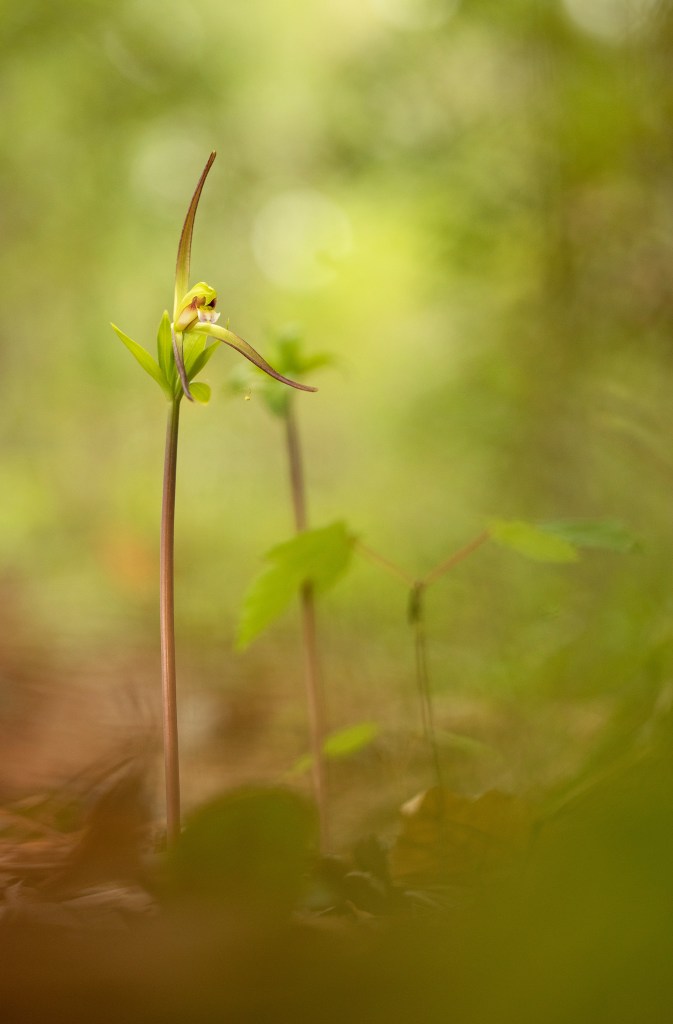
In early April I photographed the wonderfully weird whorled pogonia (Isotria verticillata), one of our most unique native orchids. To me it resembles some kind of mythical beast, with a gaping maw (petals and labellum [lip]), blunt tongue (column), and three formidable horns (sepals). They are rare in Texas, though individuals are admittedly very difficult to spot, even when in full bloom, and some populations may be evading detection.
I. verticillata is quite picky about its habitat, at least in Texas. It’s kind of like the Goldilocks of the orchid world. The forested seep, with its permanently saturated ground and extreme acidity is too hot. The rich beech slope, with its fertile loam and deep duff is too cold. But the very narrow strip where one community transitions to the other is just right.

I was thrilled when I stumbled upon this scene of blooming golden groundsel (Packera obovata) in one of our favorite patches of forest near the western edge of the Pineywoods.

When looking for wildflowers in mid April I came to hear the familiar trill of a Northern Parula (Setophaga americana) singing from the treetops. I was lucky enough to catch him out in the open as it sang from a baldcypress branch draped in spring foliage and Spanish moss.

At the end of April I found myself in Red River County, one of my favorite parts of the state. Very little public land exists here, however it is so rural that large expanses of mature forests and pockets of remnant prairies maintained for generations as hay fields still exist. I was lucky to be granted access to this incredible forest that I could not wait to explore. My excitement enhanced by the knowledge that this tract of old growth oak, hickory, and pine contained one of the few remaining populations of southern lady’s slippers (Cypripedium kentuckiense) in the state.
I set out to find them, armed with maps and descriptions provided by the landowners and the state plant ecologist. So I walked through the woods, completely absorbed in an atmosphere of spring. The crisp morning air cooled my skin. All around me newly arrived migrant songbirds were singing. In the span of half a mile I heard Northern Parulas, Black-and-white Warblers, Kentucky Warblers, Hooded Warbler, Yellow-throated Vireos, Acadian Flycatchers, Wood Thrush, and more. Southern leopard frogs leapt into small streams and depressional wetlands nestled in the forest floor.
And then there they were. Near the top of a gentle slope carpeted in mayapple and covered in huge trees. They had seemed to find the spot where little else grew to stake their claim in these old growth woods. They were in perfect bloom, though one had been recently nipped off by some hungry creature seeking a sweet snack. Each of Texas’s lady slipper populations has a unique look to them, and these were among the prettiest. They were particularly stately, with deep yellow labella (the egg shaped “slippers”, which are actually modified petals).
I spent some time with them that morning, photographing and simply admiring them. To my knowledge this population had not been visited in several years, at least not for the purpose of an official survey. I collected information on the number of stems and surrounding habitat to report back to the land managers. I was sad to see them go, but happy to know that these relics of a bygone time are still eking out an existence in this very special forest at the northeastern corner of the Lone Star State.

In May and June I focused heavily on Neotropical migrant songbirds that nest in the Pineywoods and winter in Latin America. One such bird is the Yellow-breasted Chat (Icteria virens). Chats are birds of early successional habitats. In forested systems, these types of habitats occur naturally in the wake of major events like tornadoes, hurricanes, intense fires, or devastating floods that remove canopy cover and open up the ground for invasion by grasses, forbs, and other early successional species. In my part of the world, pines are among the first trees to colonize these habitats, and young pine forests provide excellent habitat for Yellow-breasted Chats and a variety of other famously colorful Neotropical migrant songbirds. Today these habitats are more widespread on the landscape thanks to modern forestry practices. I’ve photographed many a chat, bunting, and grosbeak at young pine stands regenerating a few years after harvest.
Yellow-breasted Chats were formerly considered our largest wood-warbler, however recent taxonomic revisions suggest they are more closely related to blackbirds, and they have been placed in their own family: Icteriidae (not to be confused with the New World blackbird family Icteridae).
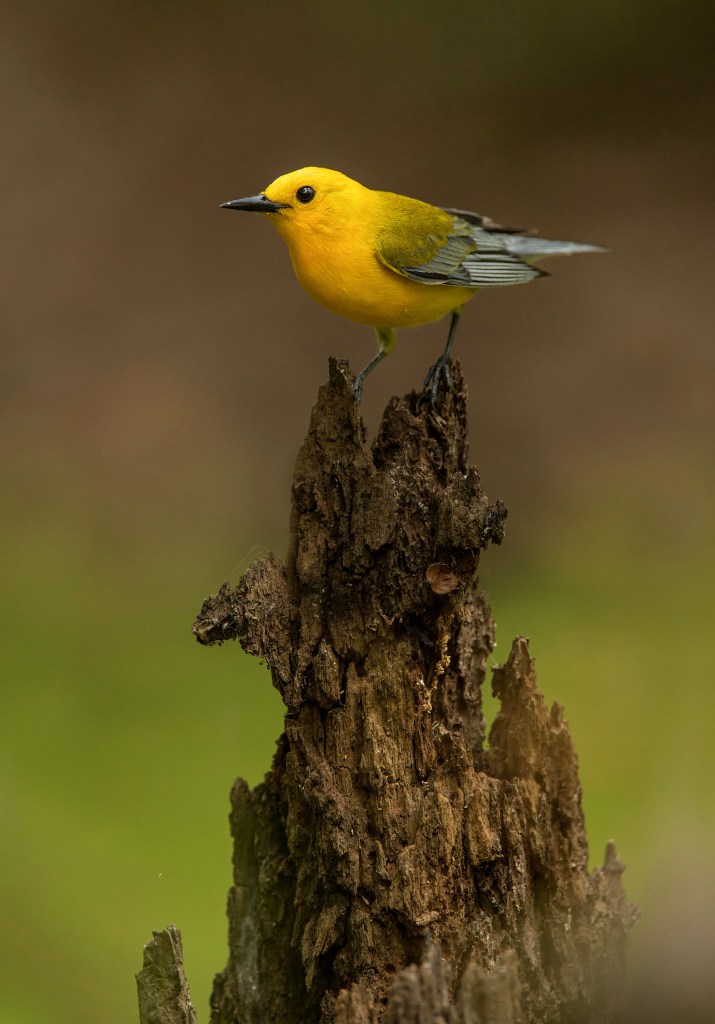
Two of my favorite images of the year, the above and below, came from the same session with the same bird. This rarely happens, but I’m happy it did on a muggy, mosquito-laden May morning. It was initially cloudy when I photographed this Prothonotary Warbler (Protonotaria citrea) perched atop a rotting stump, appearing as a flickering flame upon a decaying candle deep in the swamp.

A moment later the sun emerged from behind the clouds and cast a beam of light through the shade of a canopy of stately cypress, tupelo, and oak. The shaft of sun caught the brilliant yellow of the Prothonotary Warbler as he sang his “sweet sweet sweet” song, which carried through the forest, above the mire.
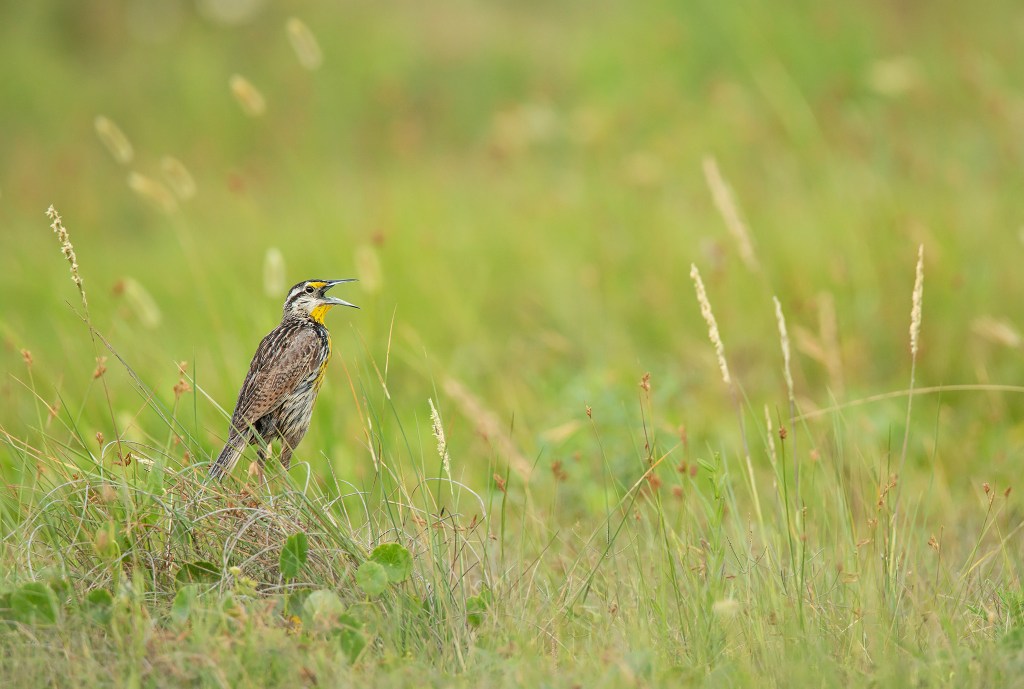
The next day we took a short trip to the coast, where I captured this Eastern Meadowlark (Sturnella magna) defending his territory in a remnant coastal prairie along the upper Texas coast. Though they remain common in many areas, Eastern Meadowlarks have experienced sharp population declines over the past century, and are emerging as a significant species of concern.

While down on the coast I had an incredible encounter with a family of Clapper Rails (Rallus crepitans), one of my all time favorite birds. I captured this image of an adult announcing its presence to the other denizens of the marsh. They are not particularly flashy, but Clapper Rails have a fascinating life history, are entertaining to watch, and inhabit some of my favorite places. They, like most inhabitants of salt and brackish marshes, are threatened by habitat loss and sea level rise.

In late June I returned to northeast Texas in pursuit of breeding warblers. For years I’ve been trying to get an image of a Hooded Warbler (Setophaga citrina) that I’m happy with. I don’t know how many hours I’ve spent sitting in wait hoping that one might present me the opportunity, but it finally did that day, when this male sang from a young sassafras in the deep woods.

Shortly after spending some time with the Hooded Warbler I found this male Yellow-throated Warbler (Setophaga dominica) in a stand of hardwoods.
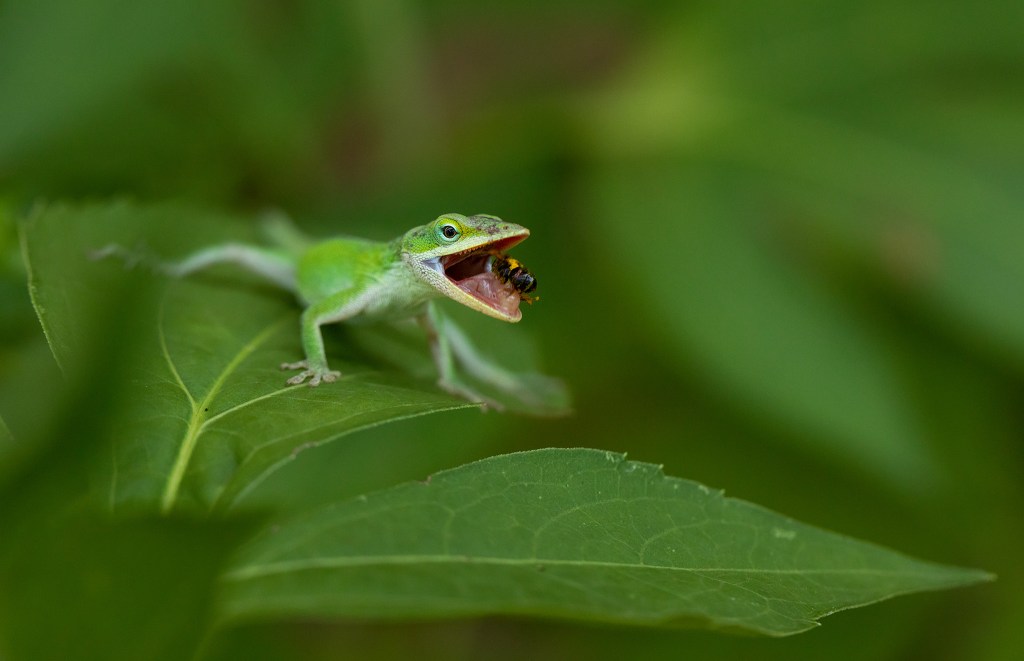
Over the next few months a combination of the oppressive heat and humidity of the East Texas summer and a very pregnant wife kept me from spending much time in the field. To help quell the antsiness I feel when I don’t get out to shoot, I spent some time in our garden observing and photographing pollinators and tiny predators. I watched this green anole (Anolis carolinensis) hunt among the flowers and leaves, snatching several small bees and wasps in the process.
Anoles are common and familiar here in the south, and many (myself included) have been guilty of considering them boring. I think they deserve more credit. Their propensity to occur in yards and green spaces in otherwise developed area makes them a great wildlife ambassador for people who don’t otherwise get out into nature, and they have no doubt sparked an interest in reptiles for countless young backyard explorers. They’re also quite interesting, able to change colors from deep brown to bright green. Some even have hints of blue when at their brightest.

In late August, we spotted this healthy female mantis on our neighbor’s mailbox. I decided to relocate her to our yard in hopes that it might improve her chances of survival and procreation. I managed to capture a few images of her before sending her on her way.

A couple of weeks after the previous image was captured our son arrived and the next couple of months found us mostly homebound getting to know each other and navigate the world of being parents to a newborn. One day in early November we set out to take him on an adventure to a nearby state park, where we encountered a group of Black Vultures (Coragyps atratus). To many, wildlife photography seems like such a glamorous pursuit. And sometimes it is! But sometimes it’s photographing a vulture perched on a dumpster full of rotting fish carcasses.

Later in November we braved our first overnight trip with the tadpole. We set out to north-central Texas in hopes of observing the white-tailed deer (Odocoileus virginianus) rut. I was lucky enough to encounter and photograph several mature bucks, including this bruiser. My experience from this cold November morning inspired me to write the following:
Dawn comes on quick this time of year. It brightens the cross timbers, first bringing light to the prairies and then to the post oak woodlands which occur as a mosaic sprawling over rolling hills.
These are ancient places, at least the ones that have not been scrubbed clean for state of the art housing developments, pastures, or crops that thrive in pockets of Blackland interspersed among the otherwise sandy belt of cross timbers that breaks the vastness of the plain from southern Kansas to north-central Texas.
This November morning brings with it a chill, blowing hard on the heels of a cold front sweeping south across the continent. The light is still gray when the deer first become visible, moving like silent specters through the grass and leaves and brush. Does, mostly, some with this year’s fawns still in toe. Browsing and scanning and not doing little else. Little else until a larger specter emerges from a tangle of limbs and vines, this one bearing curved and pronged blades on his skull like a crown.
It is lighter now. The horizon is orange and colors begin to paint the landscape. The antlered specter moves cautiously, revealing his brawny form. At first he is careful to avoid the open and risk exposure, but all caution is thrown to the wind when catches a whiff of a doe in heat, and bursts from the brush, head down in pursuit.
The white-tailed deer rut has begun.

The next morning I encountered another mature buck in the dim pre-dawn light. Mature white-tailed deer bucks are wary, elusive beings. Even during the rut, when they seem singularly focused on the continuation of their bloodline, they are almost mythical in their ability to outwit us. This is especially evident in areas with heavy hunting pressure. It’s not by chance that they’ve managed to avoid the arrow and the bullet for so long. And though during the rut many bucks will remain active well into the day, much of their activity occurs in the dark of night, and some of the more wary bucks remain almost exclusively nocturnal.
I spotted this beautiful buck just the veil of darkness over the land began to lift for the day, pulled back by the sun still far below the distant horizon. It was very dark when aimed my camera toward him. He was in a small clearing at the woods’ edge. Though the background was quite dark, it was still very cluttered and at first I thought I had little more than a documentation image. But I decided to spend some time with it, since I really liked the buck and his hyper-alert pose.
I decided to take things a bit farther than I normally do in the digital darkroom. Though I didn’t add or remove any elements, I went heavy on the dodging and burning and selectively darkened most of the image while trying to draw focus to the bucks head, neck, and antlers. My hope was to create the illusion that he was illuminated by the light of the moon in a dark autumn night.
Though I acknowledge that this walks the line between photography and digital art, I’m ok with that in this instance, because it created something that I really enjoying viewing, and that helps tell the story of one of North America’s most beloved animals.

This year the Pineywoods experienced an especially colorful autumn. Though I wish I had more time to photograph it, I was fortunate enough to get out for a couple of hours one afternoon and wander the woods. I captured this image of a fallen log, which can harbor an incredible diversity of life – a tiny ecosystem hidden among the leaf litter.
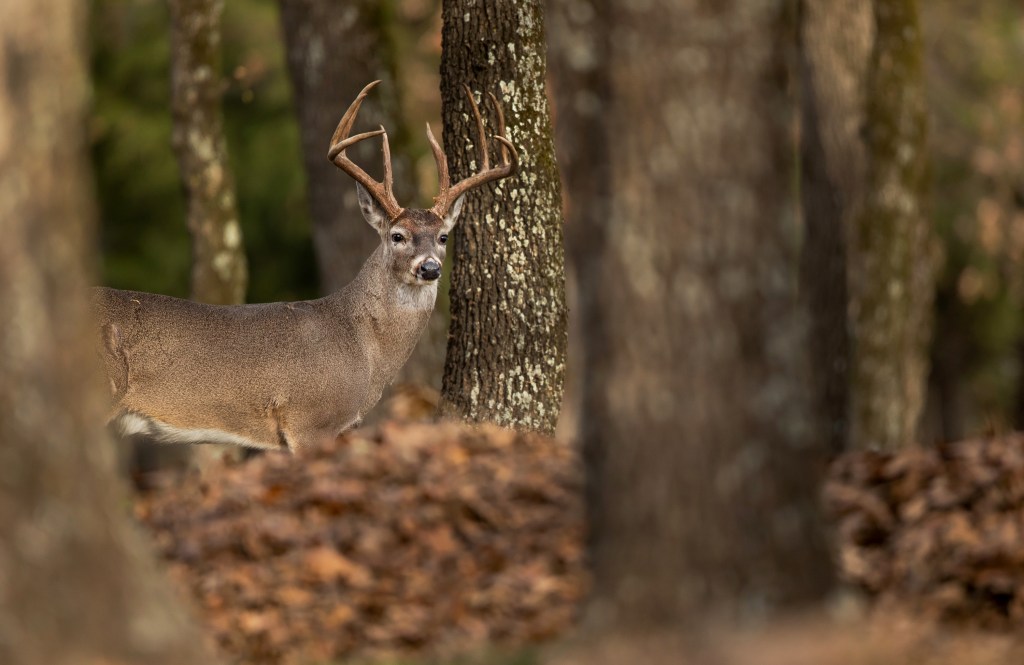
In late December we set out again to look for whitetails. This is a particularly special image for me. Despite capturing thousands of frames of whitetails in the state, I’ve never photographed a mature buck in east Texas – where we’ve made our home. I attribute this, at least partly, to the fact that they are especially elusive here. Mature bucks do stalk these woods, but decades of hunting pressure have made them wary, and few sizeable sanctuaries exist where they can become habituated to human presence. Fortunately I found one in an unexpected place and was able to observe mature free ranging east Texas whitetail bucks at close proximity. Despite this, photographing them was still a challenge. Though we could drive within feet of them, any attempt to step out of the truck or approach on foot sent them scattering for cover. Over the course of two days I was able to slowly accustom them to my presence and capture a few images. I was particularly happy with this one, with a handsome eight-point among the oaks, taking a break from foraging on acorns to scan his surroundings for potential threats.
Thanks for joining me on this journey through my favorite images of 2022. I hope it won’t be another year before I post here again. I wish you all the very best in 2023, and hope your year is filled with nature, family, and whatever brings you joy.
-Matt
